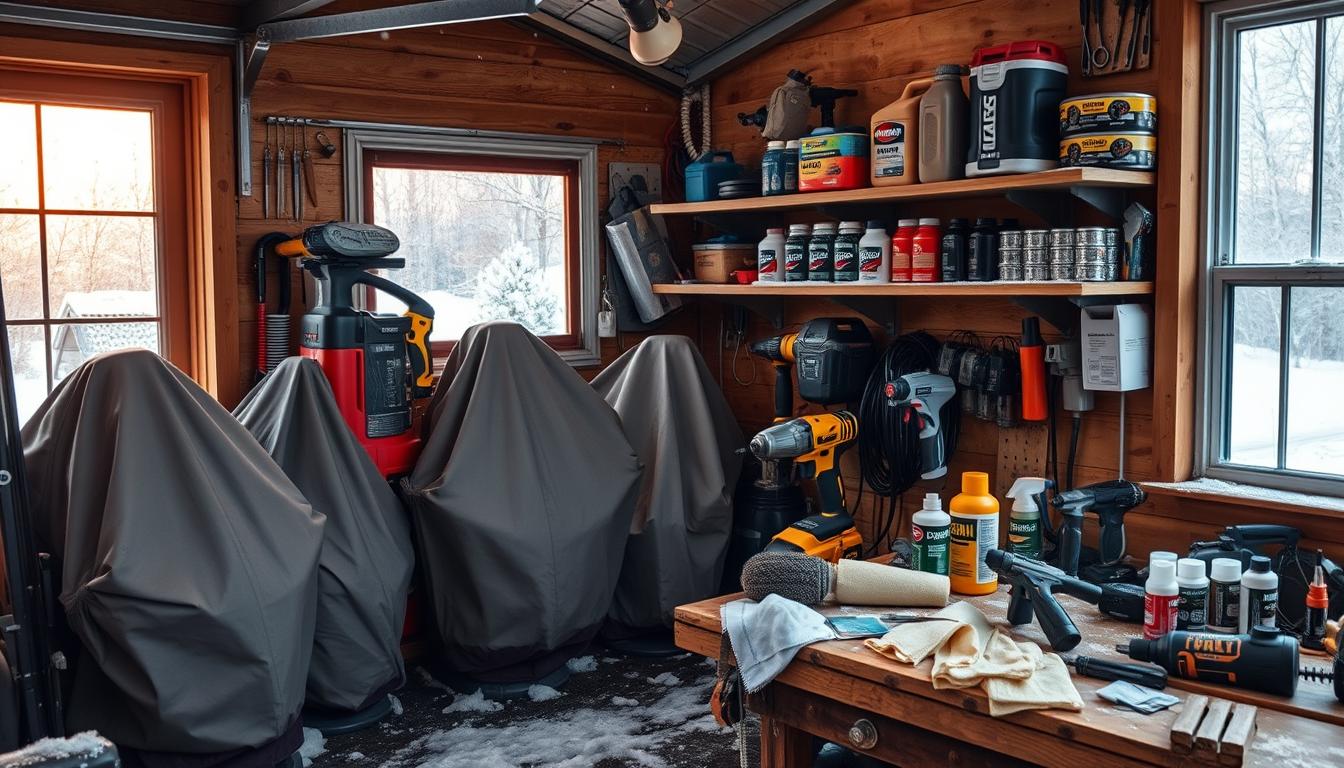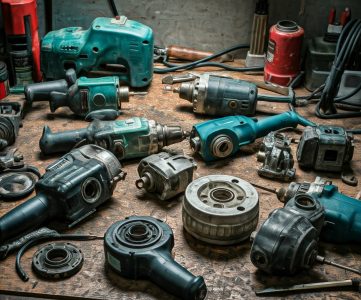Keeping your power tools in top shape is key to their longevity. Regular maintenance prevents sudden failures and saves money on repairs. A good maintenance plan is vital for your tools’ performance and life span. This article will show you how to create a schedule that meets your tools’ needs.
By taking care of your tools, you can make them last longer. Whether you use them for work or hobbies, a maintenance schedule is essential. It keeps your tools working at their best.
Key Takeaways
- Regular tool maintenance can extend the life of your power tools
- Preventive care can help prevent unexpected breakdowns and reduce repair costs
- A well-planned maintenance schedule is crucial for the longevity and performance of your tools
- Tool maintenance and preventive care can help you get the most out of your power tools
- A maintenance schedule can help you stay on track and ensure your tools continue to operate at peak performance
Why Tool Maintenance Matters for Your Power Tools
Regular maintenance is key for your power tools to work their best. Using cleaning tools helps prevent damage. This means your tools will last longer and work better.
This approach saves you time and money. You won’t need to fix or replace tools as often. It’s a smart way to save money.
Keeping your tools in good shape also keeps you safe. Well-maintained tools are less likely to break down. This reduces the chance of accidents.
Understanding the value of tool maintenance is important. It helps you see why it’s essential for your work.
Impact on Tool Performance
A tool in good condition works better and faster. Regular cleaning tools and upkeep stop dust and dirt from harming them. This keeps your tools running smoothly.
Cost Savings Through Regular Maintenance
Maintaining your tools saves you money in the long run. It prevents expensive repairs and replacements. This makes your tools a smart investment.
Safety Benefits of Well-Maintained Tools
Safe tools mean a safer workplace. By focusing on maintenance, you create a safer space. This protects you and others from harm.
Essential Power Tool Maintenance Equipment
To create an effective maintenance schedule, you need the right tools. This includes cleaning supplies, lubricants, and places to store them. A good maintenance schedule helps you keep track of when each tool was last checked. This makes caring for your tools more organized.
Some key items for your maintenance schedule are:
- Cleaning brushes and cloths
- Lubricants, such as oil and grease
- Storage containers and cases
- Tool sharpening equipment
Getting the right maintenance equipment is key. It ensures your tools work their best. A solid maintenance schedule also makes your tools last longer. This means you won’t need to replace them as often.
Remember, a well-kept tool is more efficient and safer. By getting the right tools and making a detailed maintenance schedule, you protect your investment. Your tools will keep working well for you.
Creating Your Tool Maintenance Schedule
Having a good tool care guide is key to keeping your power tools in top shape. Start by thinking about what each tool needs and how often you use it. Simple tasks like cleaning tools after each use can stop damage and slow down wear.
To make a complete tool care guide, set up a routine for daily, weekly, monthly, and yearly tasks. Create a schedule that lists the maintenance each tool needs.
Daily Maintenance Tasks
- Clean tools after use to prevent damage and reduce wear and tear
- Check for any visible signs of damage or wear
- Store tools in a dry, secure location
Weekly Care Routines
Weekly routines should include checking for wear, lubricating parts, and looking for damage signs.
Monthly Maintenance Checks
Monthly checks are vital to catch issues early. This includes battery checks, cord inspections, and tool tests to make sure they work right.
Proper Cleaning Techniques for Different Power Tools
Keeping your power tools clean is key to their performance and life span. By using the right cleaning methods, you can keep your tools in top shape. Cleaning tools is more than just wiping them down. It means paying attention to each tool’s specific cleaning needs.
Electric drills and drivers need special care to avoid damage to their electrical parts. This includes regularly checking and cleaning the vents to stop dust and debris buildup. Saw blades, on the other hand, need regular sharpening and cleaning to stay sharp.
Battery-powered tools require careful battery care. This means storing batteries in a cool, dry place and avoiding overcharging. By following these tips, you can make your tools last longer and work better.
Cleaning Electric Drills and Drivers
- Use a soft brush to remove dust and debris from the vents and exterior
- Avoid using harsh chemicals or abrasive materials that can damage the tools
- Regularly check and clean the drill bits and drivers to prevent wear and tear
Maintaining Saw Blades and Motors
Keeping saw blades and motors in good shape is crucial. This includes regularly sharpening the blades and checking the motor for signs of wear. By following these tips, you can keep your saw blades and motors working well.
Storage Solutions to Protect Your Investment
Proper storage is key for preventive care of your power tools. Good storage keeps tools safe from damage, dust, and moisture. This helps them work better and last longer.
Storing tools in a dry, safe spot stops rust and corrosion. This means you won’t have to spend a lot on repairs.
Effective storage also makes it easier to find and use your tools. Here are some options to think about:
- Toolboxes with separate compartments
- Wall-mounted storage racks
- Portable storage cases
When picking a storage solution, think about the size and type of tools you have. Also, consider how much space you have in your workshop or garage. A good storage solution keeps your tools safe and easy to reach. This makes preventive care tasks simpler.
Using a good storage solution can make your power tools last longer. It also means you won’t need to fix them as often. This saves you time and money. Remember, preventive care is important for your tools. Proper storage is a big part of that.
Battery Care and Maintenance Tips
Proper care and maintenance of batteries are key for tools that use battery power. Knowing how to keep your batteries in good shape can make them last longer. Regular cleaning tools help avoid damage and keep connections strong.
There are several important things to remember when caring for batteries. These include:
- Charging best practices, such as avoiding overcharging
- Proper storage of batteries, away from metal objects and in a cool, dry place
- Recognizing signs of battery deterioration, such as reduced charge hold time or physical damage
By following these tips and using the right cleaning tools, you can extend your batteries’ life. It’s also crucial to check your batteries for wear and tear often. Replace them when needed.
By properly caring for and maintaining your batteries, your tools will always be ready. This is true for both professionals and DIY fans. Good battery care is essential for success in any project.
Common Maintenance Mistakes to Avoid
Maintaining power tools is crucial for their tool longevity. One big mistake is not following a maintenance schedule. This can cause you to miss important maintenance steps, leading to tool failure. It’s key to make a schedule and follow it.
Other mistakes to steer clear of include:
- Using the wrong cleaning materials or techniques, which can damage tools and reduce their lifespan.
- Not storing tools properly, which can lead to damage and wear and tear.
- Not checking tools regularly for signs of wear and tear, which can help identify potential issues before they become major problems.
Knowing these common mistakes and sticking to a maintenance schedule helps protect your tools. This way, your tools will keep working well for a long time, extending their tool longevity.
When to Seek Professional Tool Maintenance
As a power tool user, knowing when to seek professional help is key. A good tool care guide can help you figure out when to fix things yourself and when to call a pro. This way, you can avoid damage and make your tools last longer.
Look out for warning signs that your tools need a pro. These include big drops in performance, strange noises, or visible damage. If you see these signs, it’s time to get a pro to fix your tools. They can find the problem and fix it, so your tools work like new again.
Knowing when to ask for help versus doing it yourself is important. Here are some things to think about:
- Complexity of the issue: If it’s too hard or needs special knowledge, get a pro.
- Cost of repairs: If fixing it costs a lot, a pro might be cheaper.
- Time and effort: If you’re short on time or effort, a pro can save you.
By following a tool care guide and knowing maintenance tips, you can keep your tools in top shape. Always put safety first, both yours and your tools’, by getting professional help when needed.
Conclusion: Making Tool Maintenance a Priority
Keeping your power tools in good shape is key to their long life and performance. By taking care of them regularly, you can make sure they work well. It’s not just about fixing issues, but also stopping them before they start.
By taking good care of your tools, you protect your investment and save money. Regular maintenance means your tools will last longer and work better. A small amount of effort now can save you a lot of trouble and money later.



